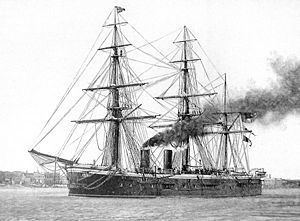Name HMS Sultan Completed 10 October 1871 Beam 59 ft (18 m) Launched 31 May 1870 | Laid down 29 February 1868 Fate Broken up, 1946 Construction started 29 February 1868 Length 99 m | |
 | ||
Displacement 9,290 long tons (9,439 t) | ||
HMS Sultan was a broadside ironclad of the Royal Navy of the Victorian era, who carried her main armament in a central box battery. She was named for Sultan Abdülâziz of the Ottoman Empire, who was visiting England when she was laid down. Abdülâziz cultivated good relations with the Second French Empire and the British. In 1867 he was the first Ottoman sultan to visit Western Europe; his trip included a visit to England, where he was made a Knight of the Garter by Queen Victoria and shown a Royal Navy Fleet Review, with Isma'il Pasha of Egypt.
Contents
Design
With the exception of some small warships designed only for harbour defence, every ironclad warship so far completed, starting from HMS Warrior, had mounted their main armament in broadside batteries. Although the turret-armed ships HMS Monarch and HMS Captain were building, it was decided by the Board of Admiralty that, pending results from these two experimental ships, Sultan would carry her artillery in a centrally-placed box battery.
The design of the ship was closely based on the design of HMS Hercules. Unlike the battery of the earlier ship, that of Sultan was on two levels; the main deck guns provided broadside fire, with limited ahead fire from the foremost gun, while the upper deck guns provided additional broadside fire and also could fire astern, by traversing the after gun on a turntable.
The hull had one of the roundest amidships cross-section ever adopted at the time of her launch, and this and the low metacentric height of only three feet made her a very steady gun platform. It was soon found, however, that she lacked adequate stability - in naval parlance she was "tender" - and some six hundred tons of extra ballast had to be inserted into her double bottom.
Service history
She was commissioned at Chatham for the Channel Fleet, in which she served until 1876. She was refitted, being reduced to barque rig, and posted to the Mediterranean under the command of His Royal Highness the Duke of Edinburgh. She was with Admiral Geoffrey Hornby at the Dardanelles in 1878.
She was then again refitted, and reduced to reserve until 1882, when she returned to the Mediterranean. At the bombardment of Alexandria (1882) she sustained casualties of two killed and eight wounded from a single hit on the battery. She was with the Particular Service Squadron during the Russian war scare of June to August, 1885, and was retained in the Mediterranean thereafter.
On 6 March 1889 she grounded on an uncharted rock in the Comino Channel between Malta and Gozo, ripping her bottom open. She slowly flooded and in a gale on 14 March 1889 she slipped off the rock and sank. She was raised in August by the Italian firm of Baghino & Co for a fee of £50,000. On 27 August Sultan was brought into Malta.
After temporary repairs she was brought home to Portsmouth, undergoing modernisation and repair until 1896. She served in the reserve until 1906, when she was partially dismantled and became an artificers' training ship under the name of Fisgard IV; in 1931 she was further converted into a mechanical repair ship, regaining her original name of Sultan. During World War II she was a depot ship for minesweepers at Portsmouth, and was sold in 1947.
